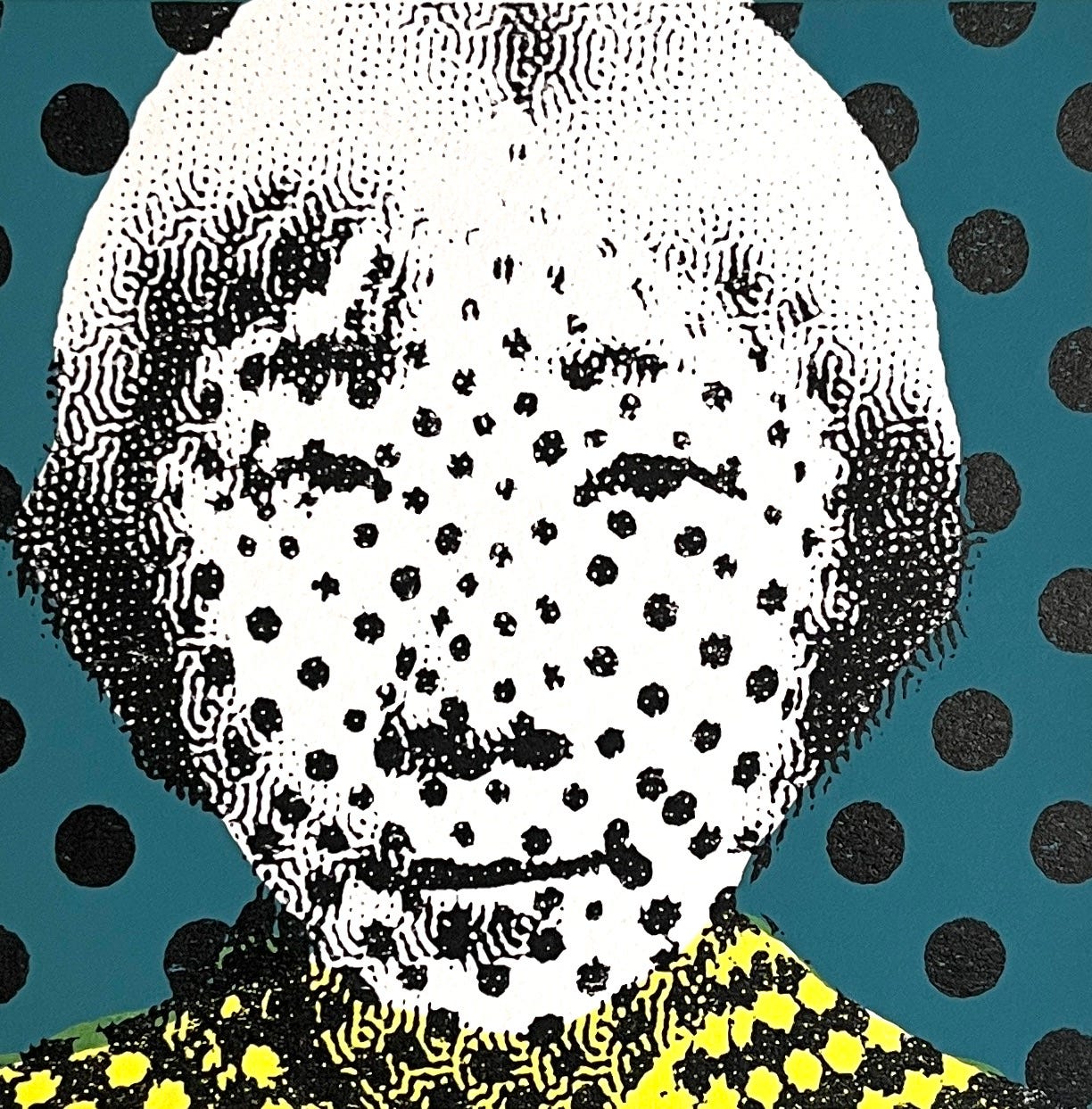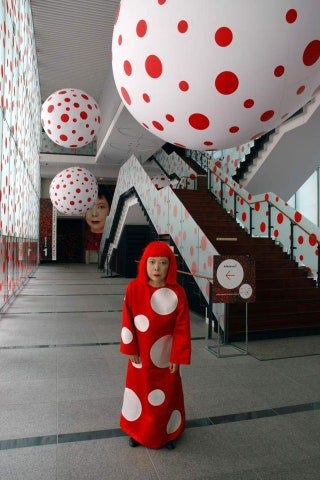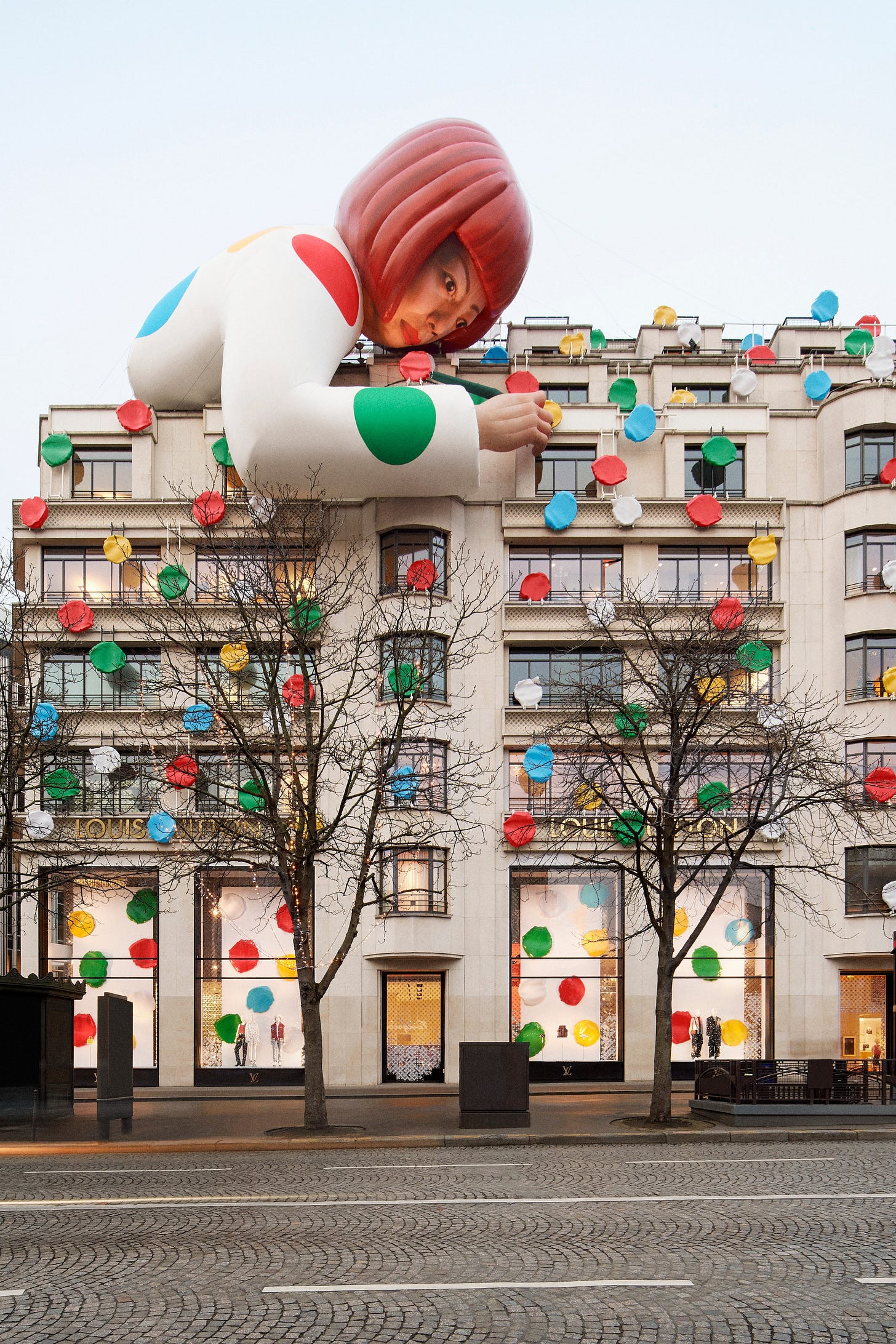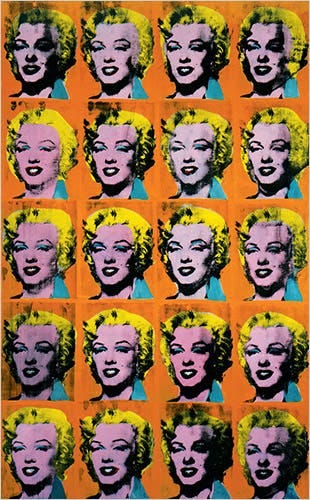This issue contains a last call for voting on our AI images, a new call for entries, and the low-down on some Kusama and Warhol SCANDALS. (If you are a new reader, I have created a landing page to help you get started. Click here!)
GIVE THE PEOPLE WHAT THEY WANT: Today is the final day to vote on our AI-generated images! Everyone will get to see the winning image, but only the voters will get to see the digital piece of art I make with it. (Could be a story, a video, or an animation. WHO EVEN KNOWS.) VOTE HERE! Or go here to the original newsletter.
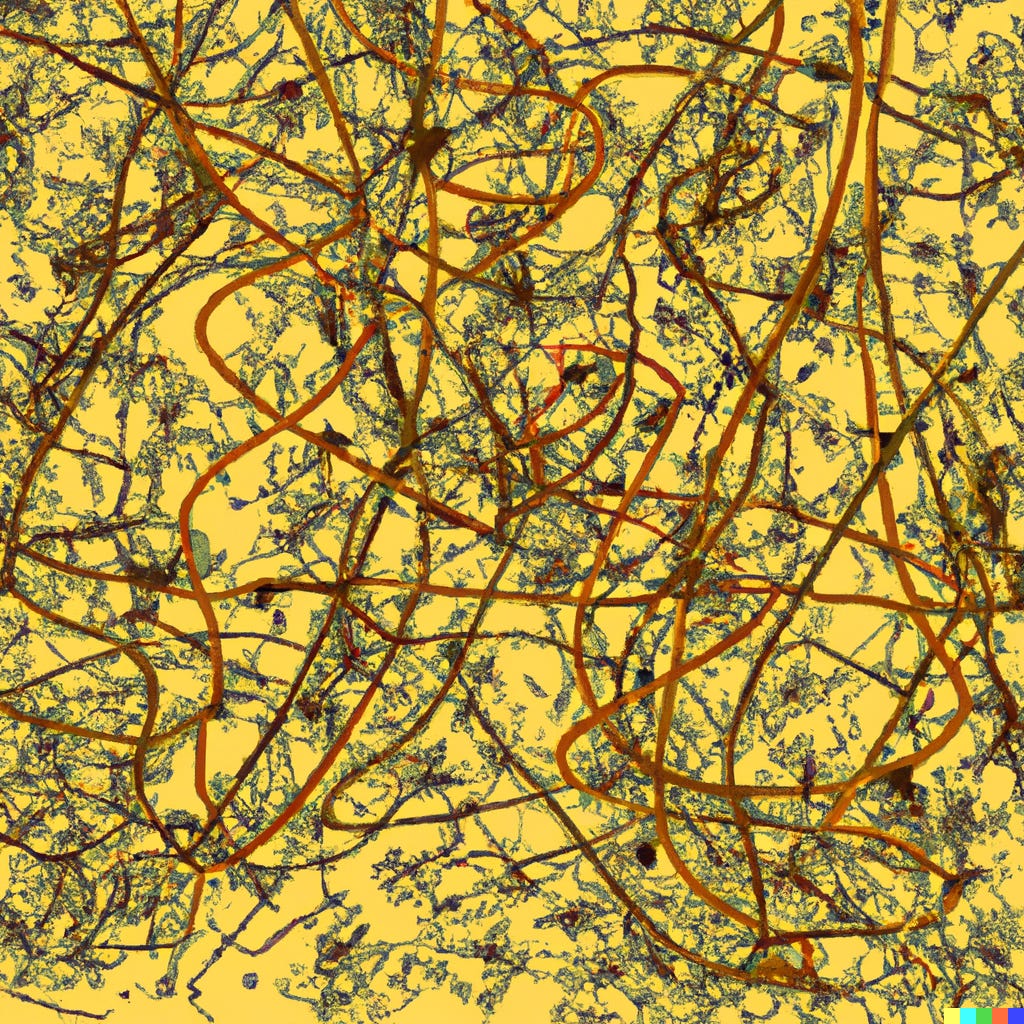
CALL FOR ENTRIES: At the bottom of this email will be a call for entries for an online art show. You do not have to be an artist to apply! Everything will be explained below, but it will make more sense if you read the rest of the newsletter.
ANDY KUSAMA STRIKES AGAIN:
After making the Andy Warhol/ Yayoi Kusama mashup for our art fund simulation, I thought we should take a moment to look at some current financial shenanigans around their work. Both artists were/are savvy business people, but there are things happening now that feel more like exploitation than artistic or economic strategies.
WHO IS MAKING MONEY OFF KUSAMA? Oh just about everybody. There was a reason why the print I made for the art fund simulation ripped off Kusama and Warhol: EVERYBODY LOVES THEM. Kusama is the top-selling living woman artist, and her work isn’t just something that gets moved around high-end contemporary art circles; she has signed a ton of licensing deals. But now that she is 93, there have been some questions about who is making the decisions for her studio. Jerry Gogosian (the satirical alter ego of artist Hilde Lynn Helphenstein) and The Art Newspaper writer Georgina Adam have both separately questioned the Kusama/Louis Vuitton “collaboration” happening right now. Kusama herself has not released any statements regarding the relationship, and it is a little murky how much input she’s actually had in what’s being produced. It would be ageist and probably a little sexist for me to assume that a 93-year-old woman cannot run her own art empire, but there are indications that she’s not in top shape, so I thought I would do some digging around to see what’s what.
Yayoi Kusama was an important figure in the 1960s New York art scene but received little recognition because she was a woman and Asian. After a reappraisal of her work in the 1980s, she managed to build an amazing late-in-life career. She’s long struggled with obsessions and hallucinations and has voluntarily lived in a psychiatric hospital since 1977. Living in a structured environment has allowed her to continue making work without having to deal with the hassle of figuring out day-to-day living stuff. (I’m feeling it.) She has a studio near the hospital where she goes to work every day if she is up for it. But like Warhol, Koons, and Hirst, her studio is actually a workshop with a battery of employees to realize her vision. On July 21, 2020, ARTnews published an article by Greg Allen, which states,
“This global activity is the culmination of the artist’s own extraordinary ambition, which has driven her practice for 70 years. But it is also the result of a supporting structure that brings together hospital, studio, fabricators, and galleries to surround her like an exoskeleton. Encased within this super-powered mech suit, she produces the artworks, exhibitions, and merch that form the infinitely dazzling Kusama spectacle we see today.”
There is a machine behind Kusama, and it appears to be headed by one of her art dealers, Hidenori Ota. Allen also writes,
“When he opened his own space, Ota Fine Arts, in Tokyo in 1994, Kusama joined his roster. For more than 35 years, Ota, who declined to speak for this article, has provided stability and guidance for this resurgent phase of Kusama’s career. He was a formative influence on her studio, the corporate entities around her, and ultimately, on her work.”
There is nothing wrong with this! Ota is doing what good dealers do, which is provide a support system for his artists so they can keep doing what they do best, which is not necessarily business stuff. He helped her leverage her new fame into opportunities, one of which was a collaboration with Loius Vuitton in 2012, and according to Arthur Lubow writing for W magazine, she was very happy about it.
“Kusama’s new collaboration, with Louis Vuitton—to make handbags, dresses, bathing suits, sunglasses, and shoes with her signature designs—evidently delights her. It is another public affirmation of her worth. “The reason I collaborate with Louis Vuitton is that Louis Vuitton is number one in the world, and I am honored to work with them,” she told me enthusiastically.”
Kusama had long been into clothing design, so this collaboration was right up her alley. But even then, she seemed a bit frail. Lubow writes that she was in a wheelchair and driven to work every day unless she was “too tired or ill.” In 2017, while speculating why he got kicked out of her studio and had his interview canceled, Vice reporter Dexter Thomas writes “Then again, she also seems recently to have some difficulty understanding her own (native Japanese) staff. They speak to her slowly, repeating things often, and instruct reporters to speak to her only in short, simple sentences, warning that she will otherwise become agitated and confused.”
This was six years ago, and I think it’s reasonable to wonder what state she is in now and ask who benefits from this new Loius Vuitton (LV) relationship. This is a huge rollout of clothes and bags with high-quality Kusama look-a-like robots painting polka dots on the windows of LV stores and giant Kusama sculptures hanging off buildings. She has stated that she wants to work until she dies, and who can blame her? Making art is a blast. Take her to her studio, prop her up, and let her go at it. Make some money off it; she’s got people to support. But is she still in control of what is being done in her name, or is she being milked for every last dime until she dies? I don’t think it’s out of line to question whether a frail 93-year-old woman with mental health issues is being taken advantage of. But, like everything in the contemporary art market, there is a lack of transparency, and it’s hard to figure out what’s going on. Artist workshops are not like fashion houses where you can transfer the brand over to someone else, so once she goes, that gravy train ends. (A new one managing her estate will begin, however.) I imagine it is not uncommon for workshops to have a management team making business decisions, but in the end, the artistic decisions should be made by the artist whose name is on the door. I see a host of ethical issues here.
Is Kusama making decisions for herself, and if not, who is making them for her? Are those decisions being made with her best interests in mind, or that of her foundation/museum/studio?
If she is not making artistic decisions outside the work she is physically making, then who is doing so? Historically speaking, when art comes from a workshop without the main artist’s input, it’s labeled “from the workshop of…” Are there new works coming out of her organization with her name but not her input? Is this fraud? My own thinking is that it’s okay for mass-market items to be designed without her, but not fine art items that folks are paying top prices for.
Who is making money from her and how much? If those people are the ones making decisions for her, that’s a conflict of interest.
I dunno. Maybe she’s fine. Maybe I’m a worrywart. But I think more people should be asking these questions.
ANDY WARHOL PRICE FIXING: It’s become pretty clear to me after doing all the research for this project so far that the top part of the contemporary art market is not even remotely open. What does that mean? People who love capitalism want markets to be unrestricted; anyone can buy, anyone can sell, and prices are based solely on what people in a given transaction agree upon. As a functional matter, modern capitalistic markets are restricted (too much for some folks, not enough for others) by things like trade agreements and regulations, but within that structure, one should supposedly be able to buy things for a fairly transparent price. This is not how the fancy art world works at all. As I’ve written before, it’s a smallish network of very rich people and the support system that enables them. They decide what art is valuable, what that value is, and who can own it. From the outside, it appears the best work rises to the top, but that’s not the case; winners are chosen, and even the most speculative parts of the market are drawn from a narrow candidate pool. I avoid conspiratorial thinking because that way lies madness, so I don’t believe there’s an official cabal setting art prices or anything. But there is a long-standing network in place, and if people want to be a part of that group, they have to uphold the network’s values and like/buy/exalt what they’re told to. It’s a fix. Andy Warhol was the best-selling artist in 2022. Is that just something that happened because he’s awesome and the world knows it? Well, he is awesome and the world does know it, but his market is very tightly controlled and it’s not just happenstance that his prices are where they are.
Let’s talk about the Mugrabi family! Jose Mugrabi and his sons are art collectors and dealers who at one point owned around 800 works by Andy Warhol. (I am not sure how many they own at this point, but they appear to be still in the game.) In 2014, Artnet published a book excerpt from economist Don Thompson, where he wrote, “It is accepted in the art world that the Mugrabis and one or two others account for 30 to 40 percent of all Warhol purchases at auction each year.” Do the Mugrabis love Warhol that much? I’m not counting it out, but I suspect they have a few other million reasons to buy all that art. The Mugrabis have a HUGE collection that includes names like Koons, Hirst, and Basquiat in addition to our friend Mr. Warhol. And they don’t just buy one or two things, they like to have a deep inventory of the artists they are interested in. If, as has been reported, there are about 10,000 or so official Warhols floating around, 800 is a sizable chunk. The Mugrabis have a vested interest in keeping the prices of Warhols (and everything else in their collection) as high as they can. That’s not just in case they want to sell some stock; I’m guessing they borrow against their collection and need to keep the values at a level to keep the cash flowing in. So, they aren’t just going to auctions to buy things; they go to bid things up. They’ll take the item home if they have to, but the goal is never to have public sales go under a certain price. And this is no secret. Almost every article I read about them mentions this, and there are other owners who are reputed to do the same thing. Collectors and art funds love Warhol because the prices are steady, and the prices are steady because the market is manipulated. Museums, the general public, and non-billionaire collectors get screwed. That’s us!
Would Warhol have cared about this? I think so. He called himself a business artist, and while he definitely liked to make money, his work was actually about business and not just a product of it. You can trace a lineage from him to Jeff Koons and Damien Hirst, and maybe the natural progression is for things to get diluted the further away they get from the source, and so we end up with investment vehicles instead of interesting art. Warhol would have LOVED being the top-selling artist in the world, but would he have enjoyed knowing that a lot of his work was most likely sitting in warehouses acting as loan collateral? Part of being famous is being seen, and considering Warhol’s acute interest in fame, I think that might have frustrated him.
CALL FOR ENTRIES: When thinking about the business practices of Koons, Hirst, Warhol, and Kusama, one thing they all do is licensing deals. Why not take advantage of the public’s insatiable appetite for their ideas? (Is this how one truly brings art to the masses? Mugs, calendars, and t-shirts?) Kusama’s LV collaborations got me thinking about what my licensed bag would look like. My friend Joe’s thesis proposal made me think about what would be in his branded luxury luggage, and then I decided that everybody deserves a chance to sell out their artistic vision and create the licensed bag of their dreams. You are invited to submit an entry to an online art show, What We Carry. Technically, this is a juried show, and I am the jury, but as long as your entry observes the guidelines and isn’t offensive, I’ll accept it. YOU DO NOT HAVE TO THINK OF YOURSELF AS AN ARTIST TO ENTER. (One entry per person. Also, no fees.)
Who: You! You do need to subscribe to the newsletter or follow me on Instagram because this is meant to be an activity for our project network. However, I’m not gonna be picky about when those things happened. Please be 18 or over.
Where: I’m going to create an exhibition catalog using Twine and host it on my website. Here is an example of something I’ve made using that technology.
When: Deadline for entry is March 6th! The show will go up on my website on March 20th and will run through April.
What: Here is the prompt I would like you to consider: If you were going to do a collaboration with a luxury brand, what would your signature bag look like, hold, or represent? This is not about creating a dream bag, but a chance to explore the commodification of identities - artistic or otherwise. You can view this as a good or bad thing, have fun or be super serious. Twine can support both images and text, so you can send me a digital drawing, a scan, a photo, or a piece of writing. You can build a mock-up of a bag, draw something, make a collage, write a manifesto, or give a brief description. I am pretty open to format and subject matter; I just want a jpeg or some kind of text file emailed to me on or before March 6. What is a bag? What is a brand? Who are you on social media? What do you carry in your purse or wallet? These are questions that might help you get started.
How: Fill out this Intent to Participate on google forms. I will collect your emails to send detailed info and reminders. The last day for receiving images/text is March 6th, but the deadline to fill out the google form is March 4th. Don’t wait until the last minute! Also, filling it out doesn’t mean you are obligated to participate. We’ve all got lives and things happen. But if you think you might wanna do this, please fill out the form. Lemme know if you have any questions by responding to this email or putting them in the comments!
Further Reading on Warhol:
https://www.nytimes.com/2009/03/01/magazine/01Brothers-t.html
https://www.economist.com/1843/2011/11/18/a-one-man-art-market
https://www.economist.com/prospero/2011/05/17/the-wizards-of-the-warhol-market
https://news.artnet.com/art-world/the-supermodel-and-the-brillo-box-22897
Further Reading/Watching/Listening on Kusama:
https://www.artsy.net/article/artsy-editorial-yayoi-kusama-built-massive-market-work
https://www.artandobject.com/articles/why-everyone-loves-kusama
https://news.artnet.com/news-pro/the-appraisal-yayoi-kusama-2062265
https://www.artnews.com/art-news/news/louis-vuitton-x-kusama-collection-review-1234652754/
http://www.kusamamovie.com/
https://www.artnews.com/art-news/artists/yayoi-kusama-museum-favorite-art-market-rise-1202694918/
http://www.artnet.com/magazine/features/itoi/itoi8-22-97.asp
https://www.wmagazine.com/story/yayoi-kusama-japanese-artist




